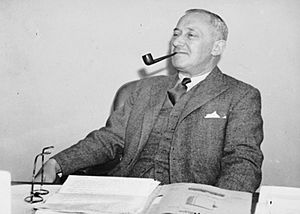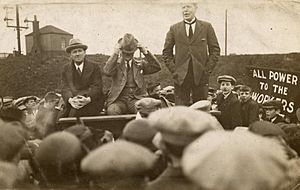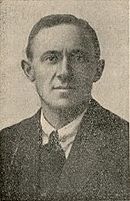Manny Shinwell facts for kids
Quick facts for kids
The Lord Shinwell
|
|||||||||||||||||||||||||||||||||
|---|---|---|---|---|---|---|---|---|---|---|---|---|---|---|---|---|---|---|---|---|---|---|---|---|---|---|---|---|---|---|---|---|---|

Shinwell in the 1940s
|
|||||||||||||||||||||||||||||||||
| Minister of Defence | |||||||||||||||||||||||||||||||||
| In office 28 February 1950 – 26 October 1951 |
|||||||||||||||||||||||||||||||||
| Prime Minister | Clement Attlee | ||||||||||||||||||||||||||||||||
| Preceded by | A. V. Alexander | ||||||||||||||||||||||||||||||||
| Succeeded by | Winston Churchill | ||||||||||||||||||||||||||||||||
| Secretary of State for War | |||||||||||||||||||||||||||||||||
| In office 7 October 1947 – 28 February 1950 |
|||||||||||||||||||||||||||||||||
| Prime Minister | Clement Attlee | ||||||||||||||||||||||||||||||||
| Preceded by | Frederick Bellenger | ||||||||||||||||||||||||||||||||
| Succeeded by | John Strachey | ||||||||||||||||||||||||||||||||
| Minister of Fuel and Power | |||||||||||||||||||||||||||||||||
| In office 3 August 1945 – 7 October 1947 |
|||||||||||||||||||||||||||||||||
| Prime Minister | Clement Attlee | ||||||||||||||||||||||||||||||||
| Preceded by | Gwilym Lloyd George | ||||||||||||||||||||||||||||||||
| Succeeded by | Hugh Gaitskell | ||||||||||||||||||||||||||||||||
| Secretary for Mines | |||||||||||||||||||||||||||||||||
| In office 5 June 1930 – 3 September 1931 |
|||||||||||||||||||||||||||||||||
| Prime Minister | Ramsay MacDonald | ||||||||||||||||||||||||||||||||
| Preceded by | Ben Turner | ||||||||||||||||||||||||||||||||
| Succeeded by | Isaac Foot | ||||||||||||||||||||||||||||||||
| In office 23 January 1924 – 11 November 1924 |
|||||||||||||||||||||||||||||||||
| Prime Minister | Ramsay MacDonald | ||||||||||||||||||||||||||||||||
| Preceded by | George Lane-Fox | ||||||||||||||||||||||||||||||||
| Succeeded by | George Lane-Fox | ||||||||||||||||||||||||||||||||
| Financial Secretary to the War Office | |||||||||||||||||||||||||||||||||
| In office 11 June 1929 – 5 June 1930 |
|||||||||||||||||||||||||||||||||
| Prime Minister | Ramsay MacDonald | ||||||||||||||||||||||||||||||||
| Preceded by | Duff Cooper | ||||||||||||||||||||||||||||||||
| Succeeded by | William Sanders | ||||||||||||||||||||||||||||||||
|
|||||||||||||||||||||||||||||||||
| Personal details | |||||||||||||||||||||||||||||||||
| Born |
Emanuel Shinwell
18 October 1884 Spitalfields, London, England |
||||||||||||||||||||||||||||||||
| Died | 8 May 1986 (aged 101) London, England |
||||||||||||||||||||||||||||||||
| Political party | Labour | ||||||||||||||||||||||||||||||||
| Spouses |
Fanny Freeman
(m. 1903; died 1954)Dinah Meyer
(m. 1956; died 1971)Sarah Sturgo
(m. 1972; died 1977) |
||||||||||||||||||||||||||||||||
| Children | 4 | ||||||||||||||||||||||||||||||||
Emanuel Shinwell, Baron Shinwell (18 October 1884 – 8 May 1986) was an important British politician. He served as a government minister for two Prime Ministers, Ramsay MacDonald and Clement Attlee. As a member of the Labour Party, he was a Member of Parliament (MP) for 40 years. He represented areas like Linlithgowshire, Seaham, and Easington.
Born in London's East End of London to a family of Jewish immigrants, Shinwell moved to Glasgow as a boy. He left school at age eleven and became a trade union organiser. He was a key figure in the Red Clydeside movement, which involved workers' rights protests. He was even sent to prison in 1919 after being accused of involvement in protests in Glasgow.
Shinwell served as an MP from 1922 to 1924 and again from 1928 to 1931. He held junior roles in Labour governments during these times. He returned to the House of Commons in 1935, winning against former Prime Minister Ramsay MacDonald. During World War II, he was a strong critic of the government.
Shinwell is well-known for being the Minister of Fuel and Power in the Attlee ministry. In this role, he helped make coal mining a state-owned industry in 1946. He was in charge of Britain's coal supply during a very cold winter in 1947. The supply system struggled, causing problems across the country. He later became Secretary of State for War and then Minister of Defence from 1950 to 1951.
After Labour lost the 1951 election, Shinwell remained in the Shadow Cabinet until 1955. He continued as a senior backbench MP until 1970, when he was in his mid-eighties. He then became a life peer in the House of Lords and remained active until shortly before his death at 101 years old in 1986.
Contents
Early Life and Union Work
Emanuel Shinwell was born in Spitalfields, London. His family later moved to Glasgow, Scotland. His father was a Polish Jew who ran a small clothing shop. His mother, a Dutch Jew, worked as a cook. Emanuel was the oldest of thirteen children.
He taught himself by reading books in a public library. He also spent time at the Kelvingrove Art Gallery. Shinwell enjoyed sports, especially boxing, and trained a local football team. He left school at age eleven to become a tailor's apprentice. He started his working life as a machinist in a clothing workshop.
In 1903, he became active in a clothing workers' union. By 1906, he was a delegate for that union at the Glasgow Trades Council. In 1911, he helped organise seamen in Glasgow for the National Sailors' and Firemen's Union (NSFU). He played a big part in a six-week seamen's strike in Glasgow that year. This strike was part of a larger national strike.
Shinwell then became the secretary of the NSFU's Glasgow branch. In 1912, he helped lead a group that broke away from the NSFU. This group became part of the British Seafarers' Union (BSU). He was the local secretary for the BSU until 1922. After that, he became a national organiser for the new Amalgamated Marine Workers' Union (AMWU).
In 1918, he tried to become an MP for Linlithgowshire but was not successful. In 1919, he became well-known for his involvement in the Glasgow 40 Hours' Movement. This movement led to clashes between police and protesters in George Square in January 1919. Shinwell was accused of being involved and was sentenced to five months in prison.
Political Career Begins
Becoming an MP
Shinwell was a member of the Independent Labour Party. He was elected as a Member of Parliament (MP) for Linlithgowshire in the 1922 general election.
In 1924, he became Secretary for Mines in the first Labour Government. This was not a Cabinet-level job. He lost his seat in 1924 but was re-elected for Linlithgowshire in a special election in 1928.
In the second Labour Government (1929–1931), Ramsay MacDonald made him Financial Secretary to the War Office (1929–1930). This role involved managing money for the army. He then served again as Secretary for Mines from 1930 to 1931. Shinwell admired MacDonald at the time. He tried to convince him not to form a National Government in 1931. However, he lost his seat again in the general election that year.
He returned to the House of Commons in 1935. He won the seat for Seaham Harbour (later called Easington). He defeated Ramsay MacDonald, who had been expelled from the Labour Party by then.
World War II and Beyond
Shinwell strongly supported the Popular Front government in Spain during the Spanish Civil War. He campaigned with other left-wing politicians like Aneurin Bevan. On 4 April 1938, during a debate in the House of Commons, he hit a Conservative MP, Robert Tatton Bower. Shinwell had been criticising the government's foreign policy. He said he hit Bower because Bower told him to "go back to Poland!", which Shinwell felt was an insulting remark.
In May 1940, he turned down a job in Winston Churchill's Coalition Government. He became chairman of the Labour Party in 1942. During World War II, he was a strong critic of Churchill's government. He and another MP, Earl Winterton, were known as "Arsenic and Old Lace" because they often criticised the government.
Post-War Government: 1945–1951
Minister of Fuel and Power
After the Labour Party won the 1945 election, Shinwell joined Clement Attlee's Cabinet. He became the Minister of Fuel and Power. In 1946, he oversaw the nationalisation of the mining industry. This meant the government took control of all coal mines. He also worked with the miners' union to create a charter for miners.
In 1947, Britain faced a very cold winter. There was a serious shortage of coal. The system for supplying fuel broke down, causing widespread problems across the country. Shinwell received a lot of criticism for how he handled this crisis. His earlier comment, "There will be no fuel crisis. I am Minister of Fuel and Power and I ought to know," was often used against him.
In 1947, Shinwell also oversaw the nationalisation of electricity. In October 1947, he was removed from his position. He was replaced by Hugh Gaitskell, who had been his deputy.
Secretary of State for War
Shinwell was then moved to the role of Secretary of State for War. This meant he was the minister responsible for the Army, but he was no longer a full member of the Cabinet. He held this position until 1950. He was seen as a strong War Minister and got along well with the Army.
In November 1947, a report suggested that Shinwell had shared secret information. This information was said to have been passed to a Zionist group called the Irgun. Shinwell knew a man who had gotten information about a military force.
Minister of Defence
Shinwell's constituency changed to Easington for the February 1950 election. After this, he was promoted to Minister of Defence. He became a full member of the Cabinet again.
During his time as Defence Minister, the Korean War began in June 1950. British troops were sent to help. Shinwell was responsible for a large rearmament programme. This programme led to high defence spending. This spending was a major reason why the government introduced charges for the NHS. This decision caused Aneurin Bevan to resign from the Cabinet in 1951.
By this time, Shinwell was seen as being on the right side of the Labour Party. Labour lost the general election a month later in 1951.
Later Political Career
Shinwell left the Shadow Cabinet in 1955. In the early 1960s, he changed his views on nuclear weapons. He opposed placing US nuclear submarines in Holy Loch, Scotland.
When Labour returned to power in October 1964, Shinwell did not become a minister again. Instead, Prime Minister Harold Wilson made him Chairman of the Parliamentary Labour Party. In this role, he worked hard to get support for the government from other MPs. He was given the Order of the Companions of Honour award in 1965. He strongly opposed Wilson's attempt to join the European Economic Community (EEC) in 1966. He resigned as Chairman of the Labour Party in 1967.
Shinwell was made a life peer on 29 June 1970. This meant he became Baron Shinwell, of Easington. He then became chairman of a group in the House of Lords that studied defence. In 1973, he published another book about his life. He remained active in the House of Lords until shortly before his death. In 1982, he left the Labour Party group in the Lords to protest against extreme left-wing actions.
Death
In October 1984, Shinwell celebrated his hundredth birthday. This was during the miners' strike. He continued to be active in the House of Lords until just before he died. He became the longest-lived peer on 26 March 1986. He died a little over a month later, on 8 May, at the age of 101. He held the record for the second longest-lived British MP for many years.
Personal Life
Shinwell was married three times. His first wife was Fanny Freeman, from 1903 to 1954. They had two sons and one daughter. His second wife was Dinah Meyer, from 1956 to 1971. His third wife was Sarah Sturgo, from 1972 to 1977. He outlived all three of his wives. Shinwell's great-niece is Luciana Berger, who used to be an MP.
Shinwell posed for a portrait sculpture by Alan Thornhill. A bronze version of this sculpture is in the Glasgow City Art Gallery.
Archives
- Catalogue of the Shinwell papers held at LSE Archives



